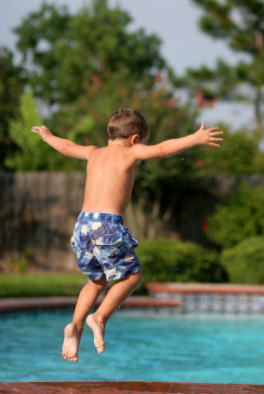Four ways to ensure best summer safety for your kids Q&A)
Tamara E. Holmes
 Baseball parks, cookouts and carnivals may be on your list of places to visit this summer, but if you’re a parent, you may end up making a stop in the emergency room.
Baseball parks, cookouts and carnivals may be on your list of places to visit this summer, but if you’re a parent, you may end up making a stop in the emergency room.
Since children are often not in a structured environment during the summer, many are prone to injuries if they are not supervised, says Dr. Allison Tothy, director of the pediatric emergency room at the University of Chicago’s Comer Children’s Hospital.
A health insurance policy will pay for a broken leg resulting from a fall at the playground and the medical payments coverage under your car insurance policy will pay for injuries that occur in a car accident. But the best way to protect your child is to prevent injuries from happening in the first place. Here are four areas in which you can implement summer safety for your child.
4 ways to practice best summer safety for your kids
1. Consider water safety.
Whether your child spends time near a pool, a lake or the beach, water safety should be a top concern. Ten people die each day from accidental drowning, according to the Centers for Disease Control’s National Center for Injury Prevention and Control. Of that number, two are children age 14 and under.
Adequate supervision would prevent many of those deaths, says Jim Spiers, president of the Safer 3 Water Safety Foundation, an organization that works to prevent drowning deaths through education. If a child is in the water, an adult who can swim should have their eyes on the water at all times without distractions such as playing with an iPad or watching a barbecue grill, Spiers says.
Other things parents can do to protect their children from water dangers include building fences around pools so a child can’t accidentally fall into the water, and learning emergency response techniques such as cardiopulmonary resuscitation CPR) to revive a child if he or she loses consciousness due to a near-drowning event, the Safer 3 Water Safety Foundation recommends.
2. Protect children from dangers of the sun.
Every year about 38 children die of heatstroke after being left inside a hot car, says safety organization KidsAndCars.org. The body temperature of children rises faster than that of an adult, and KidsAndCars estimates that a baby can die in just 15 minutes after being left in a car on a 75-degree day. Never leave your child in the car alone on a hot day even if you plan to be gone only for a minute.
Heatstroke isn’t the only sun-related danger. According to a survey by the Skin Cancer Foundation and iVillage, 42 percent of people experienced sunburn at least once a year. While you may think that’s no big deal, consider that a person’s risk of melanoma, which is the most serious form of skin cancer, doubles if he or she has experienced sunburn five or more times.
The American Academy of Pediatrics AAP) recommends that babies under 6 months old are kept out of the sun entirely if possible, and if not, they should be dressed in a brimmed hat, lightweight long pants and long-sleeved shirts to keep sunburn at bay. For older children, a brimmed hat and sunglasses are recommended again, as is sunscreen with a sun protection factor SPF) of 15 or greater.
3. Keep car safety in mind.
Before you plan your summer road trip, consider that car crashes are the number one cause of death for children 12 and under in the United States. Some of those deaths might be prevented if children are buckled in safely. The AAP recommends that infants and toddlers under the age of two sit backward in a rear-facing car seat, and children two years or older be put in a forward -facing seat. Once the child has exceeded the height and weight limits of the forward-facing seat, a booster seat should be used until the child is about 4 feet, nine inches in height, when a seatbelt should then be used.
4. Put precautions in place to prevent accidents.
Check playgrounds for safety hazards such as exposed bolts or equipment that is so high that children could become seriously injured if they were to fall.
Summer festivals and holidays such as the Fourth of July often feature fireworks, which, when lit, can reach temperatures higher than 1000 degrees Fahrenheit and cause burns, scars and other injuries. Children between the ages of 5 and 19 are among those highest at risk of suffering fireworks injuries, according to the National Fire Protection Association. The AAP recommends that only professionals handle fireworks.
Lawnmowers pose another safety hazard. It’s easy for a child to accidently get a foot or hand caught underneath a lawnmower blade, and such injuries often “tear through bone, muscle and ligaments, making the lacerations hard to repair,” Tothy says. Another risk: a lawnmower can throw up rocks and other objects that can hit and injure your child.
Keep small children out of the yard while mowing the lawn, Tothy says. Children younger than 12 should not use walk-behind mowers while those under 16 should not use ride-on mowers, the AAP adds.
You don’t have to hover over your child, Tothy says, “but you should know what they’re doing, know where they’re doing it and know how they’re doing it.”
See how much you could save today on your home insurance. Get your free home insurance quotes today!
